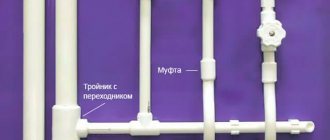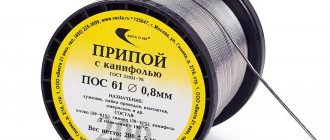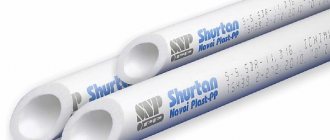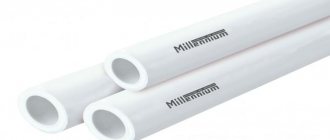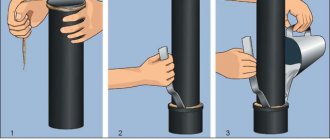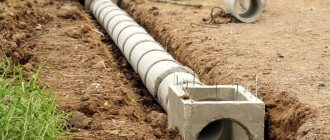Rules for laying pipes for water supply in the ground - important details
Not a single modern private house can do without a pipeline that is laid in the ground. Any water supply system requires special treatment. In this article we will talk about how to lay a water pipe underground, and about the nuances that may arise when carrying out this work.
Any type of water supply system, if it is laid in compliance with all norms and requirements, will turn out to be of high quality and will last the entire allotted service life with maximum efficiency.
Initial stage of work
Any installation of water pipes begins with drawing up a project. The scheme must be well designed, otherwise the pipeline system will not be able to function properly. This does not mean that the project should become a miracle of engineering - the main thing is that you can easily navigate the finished circuit, so that if errors arise during the work, you can easily figure it out and quickly solve them.
The project must contain the following information:
- Soil properties - its type, whether it is loose, rocky or sandy.
- The area of land over which the pipe will be laid. It is necessary to calculate so that you can always consider the number of forks and entrances.
Remember that the laying of water supply pipes must pass along a pre-leveled area. Ignoring this nuance may lead to unexpected bad consequences in the near future.
Laying depth of water pipes
Of course, in order to correctly lay pipes underground, it is worth taking into account many conditions, because any deviation from the norms can lead to malfunctions in the operation of the entire water supply system. For example, when deciding how far a pipe can be buried in the ground, it is worth considering the material from which it is made.
In addition, it will be necessary to study the individual characteristics of each type of pipe in order to understand in which cases it is advisable to use one or another type of product.
As practice shows, the optimal pipe for water supply to a private house underground is of the “HDPE PN10” type, made of polyethylene.
Products of this type are distinguished by the following qualities:
- absolute resistance to corrosion, unlike metal analogues;
- the permissible operating pressure in the system is 10 atmospheres, in addition, such pipes can be easily bent to obtain the desired configuration;
- resistance to temperature changes during changing seasons.
Selection of pipes depending on the water source
In the event that the direct source of water is a highway, it is only necessary to take into account the presence of communications. Remember that in this case, the pipe must be buried slightly below the depth of soil freezing. This is a requirement.
If you want to place your water supply from a well, you must remember that it is quite rarely laid underground, and even at the required depth. In this case, the entire pipeline must be properly insulated. In this situation, steel pipes are best suited. The fact is that, unlike all the others, they are more resistant to cold.
Subtleties of underground installation of water supply lines
When it comes to the above-ground part of the water supply system, you need to give preference to products that are strong and reliable enough to successfully withstand changes in temperature and pressure. In this case, the type of pipe described above is perfect, another advantage of which is ease of installation using fitting fasteners.
And to make it easier to decide which pipes for underground water supply are best suited in each specific case, it is worth paying attention to the existing ready-made water supply projects, proven by practice, and also take into account the requirements of technical standards. With this approach, you will get inexpensive and high-quality plumbing, and installed without much effort.
Technical standards for buried systems
You can find out information about how deep a water supply pipe should run in the ground from a special document - SNiP. All the subtleties and characteristics for pipes made of various materials are spelled out there, and it also describes at what depth one or another type of product can be laid. In essence, this document contains a lot of varied information, most of which will be, if not entirely interesting to you, then at least useful, because it will remove many related questions.
According to the regulations, the minimum depth for laying any pipe is a distance of 1.5 meters, since, often in winter, the soil freezes to about 1.4 meters. If you do not maintain such a depth, you may encounter damage to the water supply lines, which will significantly complicate, if not make it completely impossible, the further operation of the system.
It is worth noting that the depth of freezing largely depends on the type of soil in a particular region. To find out exactly this indicator, it is worth consulting with specialists who will tell you all the necessary information that you need to know. Armed with information, you can avoid many possible problems associated with temperature changes and soil freezing.
However, if you do not have access to professional advice, then simply make the trench a little deeper. By laying pipes 1.6 meters from the surface, your water supply will be protected from any surprises associated with severe winter frosts.
Technology for laying external systems in the ground
Laying pipes in an underground (closed) way is a traditional method for installing cold water supply and sewerage pipelines in the private sector. When arranging drainage, low-pressure polyethylene pipes are also used, but of a larger diameter: they are laid at a slight angle towards the septic tank.
We recommend that you familiarize yourself with: Design features and control principles of electric valves
The preparatory stage when laying pipes in the ground includes marking and digging trenches corresponding to a pre-made pipeline layout diagram. The location of future pipes from the house to the well or septic tank is marked on the site, after which excavation work begins using special equipment.
Before starting work, it is necessary to determine the properties of the soil and the depth of the aquifer, since closely located groundwater can push the pipeline out during the spring melting of snow.
Another important point before starting excavation work is the depth of soil freezing in winter. The impact of low temperatures on the pipeline is undesirable , because Pipes can burst in cold weather. The recommended depth for digging trenches is 1.4-1.6 meters. It is not recommended to bury sewer pipes deeper, because... this increases the labor intensity of work in case of repair and dismantling. If you have to lay pipes closer than 1.4 meters to the ground surface, you need to take care of insulation.
Rules for installation work
The sequence of all work on laying HDPE pipes underground looks like this:
- At the site, preliminary marking of trenches is carried out using pegs and twine, which are installed and stretched along the perimeter of future communications.
- The soil is excavated using earth-moving equipment or manually (if the length of the engineering system is relatively short).
- The bottom of the trenches is compacted manually or using a vibrating plate.
- A layer of sand or fine-grained gravel is placed at the bottom of the ditch.
- The pipeline is installed using one of the available methods.
- The trench is covered with earth.
Important! The layer of soil lying on top of HDPE pipes should not be thicker than 30 cm. Compacting the soil manually or using vibration equipment directly above the pipeline is prohibited.
To properly lay HDPE pipes, you must adhere to the following requirements:
- the depth of the pipeline must be at least 20 cm greater than the depth of soil freezing;
- the trench must be at least 40 cm wider than the diameter of the pipe;
- the thickness of the sand or gravel cushion at the bottom of the ditch is at least 15-20 cm;
- the initial coating of the pipe after laying is at least 15-30 cm, after which the trench can be buried with the soil removed during excavation.
We recommend that you read: Technology for the production of polyethylene pipes
Important! Depending on the chosen method of connecting pipes, it is necessary to provide the possibility of placing equipment in the trench. For example, if a butt welding machine is used, then the trench must be made in accordance with the dimensions of the equipment.
Possible difficulties
Obstacles to laying pipes underground can be associated with several factors:
- soil characteristics - too hard or, conversely, soft, wet, swampy and unstable soil;
- the presence of a telephone or power cable located close underground, underground technical structures (wells, hatches, neighbors’ septic tanks).
If the land plot is too loose, swampy or hard and rocky, then digging a trench to a safe depth for pipes will not be possible. In this case, it is necessary to use additional methods of insulating the pipeline and strengthening the soil.
Step-by-step instructions for doing the installation yourself
When the excavation work is completed and the trenches are prepared, it is necessary to carefully place the pipes in them. They can be connected to each other in two ways:
- butt welding;
- electrofusion welding.
The first method is used to connect large diameter pipes, for example, when installing a sewer system. To do this, you need a special device that heats the ends of the pipes to the required temperature.
Electrofusion welding involves the use of a special connecting element that is placed over the pipes. Due to the presence in the structure of the product of a metal element that conducts current, the pipe is heated to the melting temperature and forms an inextricable connection of molten polyethylene.
Attention! If you are installing a cold water supply pipeline and using pipes with a diameter of up to 63 cm, then compression fittings are also suitable for connecting them, which allow you to quickly fix the joint, achieving a high tightness of the connection.
Depending on the connection method you have chosen, the installation algorithm may look like this:
- Pipes located in the trench are centered relative to each other.
- The surface of the products at the joints is cleaned and degreased.
- An element for electrofusion welding is put on the pipe in advance and aligned symmetrically between the connected pipes.
- Using a generating apparatus, a current is supplied to the coupling, leading to the melting of the plastic.
We recommend that you familiarize yourself with: Insulation for protecting pipes, made of foamed polyethylene (thermal insulation)
In this way, all pipe sections in the trench are soldered.
The most common mistakes made when laying underground pipes
The underground installation of communications, of course, largely depends on the type of soil in a particular location. And, often, many difficulties arise with it during work, since the composition of the soil may simply not make it possible to deepen the pipes to the distance specified in SNiP. In particular, the soil may be very compact, rocky or boggy, so that you simply cannot get to the desired depth. In this case, many difficulties can arise in winter.
However, even in this case, there is a way out - insulating water supply pipes in a private house in various ways. In this case, a reasonable option would be to dig a trench as deep as possible and insulate the pipes well. Read also: “Types of water pipes - characteristics, advantages and disadvantages of materials.”
It is worth noting that insulating a water pipe will not be superfluous in any situation, even if you can deepen the system as much as possible. One of the best insulation options is to lay a heating cable along the pipe. There is also a special pipe for laying cables in the ground, which is used when laying electrical communications.
However, this method is not cheap at all and is associated with significant financial and labor costs. But still it is considered the most reliable. Of course, by doing all the work yourself, you can save a little, and you will also gain some experience that may be useful in the future.
If you live in a region where winters are quite mild, then do not go to extremes. Water pipes should not be placed too close to the surface due to the risk of mechanical damage. At the same time, deepening them too much risks the appearance of cracks due to high soil pressure, which will eventually lead to failure of the system.
Pipe for water supply in the ground and laying water supply
You always have to pay some fee for living in your own home, enjoying peace and quiet, and working to improve your home. Now we are talking about different systems that provide comfort in life and the responsibility of their organizer and owner. If you live in an apartment building, then the utility workers will do everything for you, but if you have a private home, then be so kind as to be responsible for everything yourself. A typical example would be a plumbing system. What is its efficiency and functions in different climates? The answer to this question is very simple; everything will be fine if it is laid in the ground correctly and according to the rules. How to properly produce and install an autonomous water supply system in a private household? This is exactly what we will talk about in our article.
First beginnings in laying work
First of all, always first create a laying diagram, the so-called project. This will certainly not be the creation of the greatest architect with the inherent style and correctness of the image. But, nevertheless, the most important data must be present there, and first of all, you need to pay attention to the following.
- Laying a water supply system in the ground directly depends on the type of soil in the area, whether it is loose or soft.
- The total size of the entire area on which the water supply pipe will be laid is what makes it clear what the approximate number of “entry holes” and forks will be.
Important ! Before laying water pipes, you must level the land.
Pipes, what material is best to use?
How deep to bury pipes? This is a constantly burning question that constantly hangs in the air and in the minds of people who want to do everything with their own hands. The correct conclusions should be drawn, first of all, by correctly determining the type of pipe. It is their individual characteristics and qualities that are completely unique when a water pipe is laid in the ground. Skills accumulated over time show that the best way out of the situation is the HDPE PN10 pipe. In simple terms, this is a material consisting of low-pressure polyethylene, which is quite suitable for laying pipes through which drinking water will flow.
Those. Characteristics of this type of pipe.
- They are not subject to various types of corrosion, unlike metal ones.
- They maintain a pressure of about 10 atmospheres.
- Very durable, that's what makes them unique.
- They bend in different directions very easily and easily.
- During the winter period they behave quite predictably and withstand everything very well.
The structuring of the soil directly affects the quality of the ditch.
Attention! There are pipes of the “PN 6” brand; they are certainly more economical, but do not waste your nerves by buying a cheaper product, because during use there will certainly be nuances and problems.
A special pipe for laying water pipes in the ground
In addition, pipes of the first type, “HDPE,” are installed very quickly, and their fittings are not that expensive. We are not asking you to make a specific water supply directly according to our article, you can consider and read any option yourself, everything will be the way you decide for yourself, and what means and opportunities you will have for this. Laying a water pipeline in the ground price: The average cost of laying 1 m/p of water pipeline from HDPE pipes DN 50mm in an open way is 2000 rubles / 520 hryvnia / 60 dollars.
Regulatory Definitions
So, first of all, we turn to SNiP, so as not to think once again about how deep the water pipe should be. This documentation determines, first of all, any technical nuance, down to the depth of the ditch for laying street pipes carrying water. In view of the developed regulations, the depth of pipes should be at least one and a half meters. Moreover, this instruction has every reason:
- Most often, the ground freezes to 1.4 meters, and if you make a ditch less than 1.6 m, this can lead to freezing of the water in the pipe and the impossibility of using the water supply system physically almost all winter until the thaw.
- How your area freezes depends on your location. It’s better to consult with some construction company in your city. Usually they dig in the ground all year round, and it is in view of this that they will be able to explain to you exactly what the depth of freezing is and what is best to do.
Attention. At a level deeper than 1.6 meters, the temperature is stable.
Some problems and nuances when laying plumbing in the ground
Usually the biggest problems occur when the soil structure does not allow you to go deep enough. What are we doing? We tear everything out as much as possible. Next we lay the pipes, but before that we make good thermal insulation. And, ultimately, an important aspect that is mandatory for the normal and proper functioning of the water supply system is the installation of heating cables along the entire length of the pipeline system. Of course, this version is very, very cost-effective, and it takes a lot of effort during installation. But, ultimately, this is the best option, under the given conditions.
Attention: even if the plumbing system is installed in a warm area, if the pipe is too close to the surface, this will inevitably lead to damage sooner or later. But if you buried it too deeply, then under the influence of high pressure it will simply become covered with cracks. Tips on how to insulate your plumbing
Important! Read the article about insulating water pipes in the house.
You have done everything as it should, there is only one thing left to do, fill the pipeline system, but before you do this, please do a test run of the liquid. Observe how it flows, whether there are cracks, leaks, and whether it flows freely. And also look at how firmly all the nodes are connected. Only after all these procedures can you consider this exciting business completely completed.
Insulation of water pipes in the ground video:
We also recommend you:
Insulation methods
It is necessary to carry out work on insulating water pipes, because at low temperatures the water will freeze and the system will stop working. Therefore, it is important to make every effort in advance to prevent such troubles from happening. This is especially true for the above-ground part of the pipe running along the street and through unheated rooms.
To decide on the right material for insulation, it is worth considering the following factors:
- since in the private sector owners often carry out all construction work themselves, the process of installing insulation should be as simple and convenient as possible so as not to create difficulties for beginners;
- long service life of products, which will allow you to do without additional measures for as long as possible;
- non-flammability of the material and its fire safety;
- creating an airtight coating;
- the correct ratio of quality and price of the material, which is very important.
So, taking into account all the listed factors, the insulation must meet the following parameters:
- low thermal conductivity;
- ability to absorb moisture well;
- resistance to environmental influences;
- resistance to temperature fluctuations.
All these indicators are decisive when choosing the optimal material for pipe insulation. By and large, there are few varieties of insulating materials, so choosing something suitable is not so difficult.
If the installation of the water supply system is made of metal-plastic pipes, then the choice can be made with thermal fiber. It has a low density, which is its main advantage. However, such material requires additional insulation, which significantly increases the duration and cost of work.
Basalt wool has good quality characteristics and a convenient installation method, however, such insulation is quite expensive.
Expanded polystyrene is an excellent material for insulation; it is in great demand among consumers. It can be used for both external and internal work, and the strength of the material allows its reuse in the event of dismantling the system for repairs, for example.
To lay polystyrene foam, the shell needs to be divided in two, first put the first part on the pipe, and then place the second part overlapping. After installing all the insulation elements, the joints must be sealed with several layers of tape. The shaped shell is very convenient to use when working with corners and turns in the water supply system. Thus, there is nothing complicated in insulating pipes using polystyrene foam - even a beginner can handle the job.
To disassemble the layer of this insulation, all these manipulations will need to be performed in the reverse order.
So, in conclusion, we can say that provided you comply with all accepted rules and regulations for laying underground communications, you can get a high-quality and durable water supply system. Please note that when connecting water pipes to the house, you should not rush to fill the trench. First, you should conduct a test run to eliminate any problems and correct them in time. At the end, you need to carefully inspect the joints again to make sure that everything is working correctly. Only then can the work be considered complete.
Source
Requirements for underground pipes
What qualities should pipes laid in a trench have:
- Not afraid of wet soil and not subject to corrosion.
- Do not interact with alkalis and acids in the soil.
- Have reliable installation connections.
- Withstand soil pressure.
- Guarantee long service life.
In seismically unstable areas, it is necessary to use pipes that are flexible so that they do not collapse when the soil moves.
If there is a need to install the main line in winter, the frost resistance of the material used will be required.
Which pipe to choose for underground water supply?
Advantages and disadvantages
- Resistant to long-term gas exposure.
- The service life is about 100 years, if the pipeline is not overloaded.
- High level of flexibility. Thanks to this, it is possible to manufacture highways of complex configurations.
- Low weight of individual elements.
- No sediment accumulates on the smooth walls of the product.
- The material is not susceptible to rust.
- Not resistant to high temperatures.
- Plastic pipelines cannot be installed outdoors, as the material loses its technical characteristics in the cold.
- When heated strongly, the material expands. Because of this, to increase the strength of connections, individual sections of the pipeline need to install compensators.
- Low resistance to ultraviolet rays.
If you do not overload the pipeline, it will not break down and will withstand decades of active use.
Regulatory documents conditions and requirements for pipeline construction
The standards determine the laying of any pipeline, regardless of what material it is made of. Many technical issues are regulated in the so-called SNiPs.
They ensure safety and allow any work to be carried out efficiently. Here are a number of requirements that must be met for installation in the ground.
- Accounting is required for the point at which the soil freezes. Its level is often 1.4 meters. In winter, the water inside the water supply will simply freeze if it is located lower. The operation of the water supply will become impossible.
- The laying and its method may vary depending on what structures and structures are already present on the territory. And from the presence of highways, communication networks, highways. It is better to contact specialized companies if you are not completely sure about where to carry out the installation.
- The characteristics of the soil and topography are important for those who lay underground water pipes.
Features of choosing a water pipeline for laying in the ground
The type of products for the underground pipeline is selected depending on the type of soil and the source of drinking liquid. When creating communications for supplying water directly from the point of its intake, the type of pipes may not be important. The line is buried half a meter below the freezing point of the soil. On average, the depth of the trench is 1.2-1.5 meters.
The installation of water supply from a well will require the installation of pipes that are highly resistant to cold. Otherwise, reliable insulation of the main line should be performed. You can install a heating electric cable on the structure. Steel products are less sensitive to low temperatures, but their disadvantages encourage the purchase of polyethylene analogues. To supply water to the garden, there is no point in purchasing products made from high-density material. A plumbing system of this type is not deeply buried.
Rules for laying in the ground with your own hands
GOST says that for laying in the ground, pipes must have a diameter of at least 32 millimeters. For convenient and quick installation, a set of fittings is purchased.
- First, a trench is dug in the ground. Standards indicate that the depth of the trenches must exceed the freezing level of the soil. It is better to use special tables to determine the freezing level specifically for your region. 0.5 meters is the optimal width for the seam.
- We compact the trench - the bottom and also the walls.
- They create a cushion that provides shock absorption. For it, it is enough to pour a layer of, for example, sand gravel or sand of approximately 10 - 15 cm.
- It is mandatory to wrap the water supply pipe with a heat-insulating layer. Then the products are laid in a ditch and connected using fittings.
- We fill the pipeline with sand. The main thing is that the highest point is 5 centimeters higher than the pipeline itself.
- We cover the place where the water supply is located with tiles. In this case, broken bricks and tiles will become indispensable assistants.
- We fill the trench with earth. It is easy to understand that installing polypropylene pipes in the ground is not such a complicated process.
Types of water pipes
Very often, people in their summer cottages need to face the issue of equipping their home with a cold water supply; cases with hot water are less frequent. Such houses are located far from the city, and communications are practically inaccessible here.
Laying HDPE pipe underground
To ensure that the supply of cold water occurs without delay, you can use the following tips:
- Steel pipes have fairly high strength. They are affordable and have a fairly low coefficient of thermal expansion. Such pipes have their drawbacks. The thing is that steel products are quite heavy, their installation is difficult, and the fact that there is a slight decrease in the entire working section over time forces us to look for a possible alternative. How quickly or slowly the metal underground corrodes is a secondary factor. Remember that the corrosion rate of steel pipelines, unlike cast iron, is no more than 0.1 millimeters per year. Based on this, we can say that such pipelines can be used for forty-five or even fifty years.
- Plastic. The category of plastic plumbing includes all products made of polyethylene (PE), pipes made of polypropylene (PP), and pipes made of polyvinyl chloride (PVC). The main advantages of this water supply are their flexibility, lightness, complete chemical inertness and, of course, a fairly high throughput. Due to the flexibility of plastic pipelines, their installation allows the construction of fairly complex systems. There are few disadvantages of plastic water pipes. Their first disadvantage is low mechanical strength, but this does not matter for laying plastic pipes in the ground. Their second drawback is instability to high temperatures.
- Metal-plastic water supply . This type of water supply includes polymer pipes and water pipes that are reinforced with aluminum. They are much superior to plastic ones in their strength and temperature resistance. These devices can be used not only for cold water supply, but also for hot water. Moreover, they can even be used for heating systems. The only drawback of such pipes is their high cost.
Advantages of using polypropylene pipes
Polypropylene pipes are optimal for laying sewer systems for summer cottages, supplying water for domestic needs, watering gardens, and greenhouses.
The use of polypropylene pipes today is justified in many areas, from water supply to sewerage. Among the advantages of using such pipes are:
- resistance to corrosion and various mechanical influences;
- ease of installation (trench method), which does not take much time;
- the possibility of using polypropylene pipes for supplying drinking water;
- reliability and strength.
Suitable pipes for installation in the ground
Marking of pipes for drinking water
Traditionally, welded or seamless steel products are used for these purposes, preferably galvanized to protect against rust. However, now they have been replaced by polypropylene and plastic options, for example, HDPE PN10. They have many advantages:
- resistance to corrosion and temperature changes;
- increased working pressure - up to ten atmospheres;
- ease of installation - polyethylene pipes are easy to bend.
An important plus is the budget price. This factor makes the cost of laying a water supply system from propylene pipes in the ground per linear meter lower compared to steel ones.
The diameter of the pipe for laying in the ground according to GOST should not be less than 3.2 cm. The length of the standard product is 240 cm.
Characteristics
The technical characteristics of the material determine the scope of its application. When making a gas pipeline, you can use different types of plastic pipes. Each of them has its own technical characteristics.
- High chemical resistance.
- The material is not subject to oxidation.
- The maximum coolant temperature is up to 95 degrees.
- The maximum permissible pressure is up to 25 bar. If the temperature is high, the permissible pressure is reduced to 10 bar.
- The thickness of the metal layer between the plastic is up to 0.3 mm.
- outer diameter of tubes - 10–110 mm;
- maximum coolant temperature - up to 95 degrees;
- at high temperatures the maximum pressure is up to 10 bar.
- maximum coolant temperature - 90 degrees;
- permissible pressure at maximum temperature - up to 10 bar.
Polypropylene pipes can withstand short-term overheating up to 110 degrees.
Diameter of plastic pipes
Independent search for underground pipes
The material from which the required elements are made is of great importance. This determines not only how to find water pipes in the ground, but also what to look for and what to do.
Technologies vary, and a modern method of independently searching for underground utilities can be aimed at determining the location of:
- Metal water pipes for hot and cold water.
- Steel heating “T” in collectors.
- Power cables and wires of communication systems.
- Cast iron sewer lines.
- Plastic, polyethylene, polypropylene pipelines;
- Metal-plastic and ceramic technical means of supply and drainage.
To fully probe an unfamiliar area for the presence of underground routes, all methods are used. In this case, the choice of technique depends on the installation depth and the actual operating pressure of the liquid inside the pipeline.
Application of a metal detector
If the pipe was laid at a depth of up to one and a half meters, it can be detected using metal detectors (professional, semi-professional or amateur). At the same time, the presence of insulation and waterproofing on the “T” does not interfere with the procedure.
The price of equipment can reach up to 130 thousand rubles. This means that for one-time use, its purchase is impractical. Cheap models cost up to 6 thousand, but they are less effective.
Features of laying water pipes underground
Comfortable living in a house or apartment largely depends on the correct installation and normal operation of life support systems. If in a multi-storey building the maintenance functions are assigned to employees of special services, then in a private building the homeowner is responsible for everything. Proper installation of water supply and sewerage will save owners from the work of heating frozen elements and cleaning the drainage system due to an incorrectly chosen slope.
Laying water pipes underground
What pipes are suitable for laying in the ground?
In order to determine which pipe is best for underground water supply, it is necessary to have data on the structure of the soil and the length of the water pipe. In most cases, the choice of system material depends on these parameters. In addition, the choice of water pipeline elements is influenced by the depth of soil freezing in a given region.
Low pressure polyethylene pipes are most often used. An underground water supply system made from this material has fairly high strength characteristics. It is durable, non-corrosive and designed for a pressure of 10 bar.
Some homeowners prefer polypropylene pipes. Their installation is simple, because the connection is made using threaded fittings. Such elements can be used for supplying and distributing hot water. If the developer prefers metal pipes, then it is better to use galvanized or stainless steel. You need to know that metal is susceptible to corrosion, which reduces its service life, and long-term use affects the quality of drinking water.
Laying water pipes in the ground
To correctly install the system elements, it is necessary to prepare a design or diagram of the water pipeline indicating the installation locations of fittings and possible branches. The data is then transferred to the area and adjusted if necessary. After this, they begin to dig a trench. Its depth should be at least 1.4-1.5 m, and its width should be about 0.6 m.
The laying of a water supply system from polypropylene pipes in the ground begins from the water source (well, well, etc.) or the point of connection to the main network, to the house. The assembly of the water pipeline elements is carried out on the surface and then laid on a sand cushion in a trench. During installation, it is necessary to avoid sharp turns and bends of pipes. If it is intended to cross the sewer system, then the water supply must pass 0.2 m above it. It is not allowed to lay the water conduit at a distance of less than 0.75 m from electrical and telephone cables and 2 m from the drainage system.
After positive test results of the system for density, the ditch is backfilled. The soil layer in direct contact with the water supply should not contain large stones or construction debris.
Part 3. Laying a pipeline from the well to the house
How to determine the depth of laying water pipes?
The depth of the water supply depends on the freezing of the soil, its structure, the proximity of groundwater and other factors. This data can be requested from the nearest organization engaged in similar work or obtained independently by drilling several control wells along the proposed trench. In many regions, the depth of soil freezing does not exceed 1.6 m. If for some reason it is impossible to reach such a depth, then laying the water pipe in the trench should be carried out with preliminary insulation.
The proximity of the location to the surface of groundwater negatively affects the material of the water pipeline. In this case, the network is waterproofed or the depth of the trench is reduced, followed by insulation of the system. If the water pipeline passes under areas where heavy loads are expected, then in such places it must be buried or additional elements must be installed to protect the pipeline from destruction. If the system is laid through open areas devoid of vegetation in regions with a hot climate, its depth should be at least 0.5 m.
Taking into account all these nuances, you can accurately determine at what depth to bury water pipes.
Laying polypropylene pipes
The depth of installation of water pipes made of polypropylene does not differ from elements made of other materials. Installation is carried out using soldering with a special soldering iron. The optimal heating temperature for the working part is +260…+270°C. The quality of welding is affected by the heating time of the seat. Overheating, as well as underheating, leads to a defective seam. Re-welding is possible after removing the defective section.
It must be remembered that polypropylene systems are not flexible enough. Excessive bending may cause the element to fail. To organize a turn or outlet, tees, angles and other fittings are used. To deflect the water pipe at an angle of 90°, it is advisable to use 2 angles of 45°. This reduces the hydraulic resistance of the system and protects against water hammer.
Laying steel water pipes
Due to the fact that metal pipes for underground water supply are good conductors, they must be grounded. These works are carried out taking into account the requirements of norms and regulations. Coming up with home-grown protection against stray currents is not only prohibited, but also dangerous. Often, steel water pipes are connected as a grounding loop.
Autonomous water supply systems in private households are not grounded at all. If you still decide to ground the pipes, then the grounding electrode is connected by welding. It is strictly forbidden to drain the water supply system.
Pipe installation is carried out using welding or bending. The latter is more practical, but the connecting node is the “thin” point of the system. In most cases, after a few years, a fistula forms on the thread of the pipe. It is recommended to lay metal elements below the freezing point of the soil.
Which pipe is better: PPR, polyethylene or metal-plastic?
Features of laying pipes for hot water supply
It is desirable that pipes for laying water supply systems in the ground, transporting hot water, have reinforcement. Regardless of the installation depth, they must be insulated. This will prevent heat loss. Hot water pipelines should not be rigidly fixed in the trench. Heating of the elements leads to their expansion and shift in the longitudinal direction.
A possible problem may be laying a hot water supply pipeline in a trench of less depth than the freezing point of the soil. The issue is resolved by using additional insulating materials.
What about insulation?
In most cases, underground water pipes require additional insulation. This can be achieved in several ways:
- Water pipe gasket in a case. Often used for trenchless installation.
- Filling the water tank with foam concrete.
- Insulation with insulating mats.
- Heating by heating cable.
- Increasing pressure in the system.
Insulated networks cause less trouble in winter and function properly despite low temperatures.
Source: https://trubyda.ru/vodoprovodnye/prokladka-v-zemle
Is it possible to use polypropylene pipes for gas?
In Western countries, metal pipes are used only for the assembly of industrial pipelines. In the manufacture of water and gas supply systems, plastic elements are used. This is due to the performance characteristics of the material. Gas flows through a plastic pipe without any difficulty. Before putting the gas pipeline into operation, it is necessary to check the tightness of the connections of individual elements in order to prevent violation of the integrity of the system.
You can figure out which is better – a pipeline made of metal or plastic – by comparing these two materials. Differences:
- Weight - plastic pipes weigh less than metal parts. Thanks to this, they are easier to install; they do not require additional fastenings on vertical surfaces.
- Versatility - There are more factors to consider when choosing metal pipes than when using plastic parts.
- Price - tubes made from polymers are cheaper than metal ones.
Metal tubes are superior to plastic ones in terms of strength, durability, and resistance to mechanical stress.
Laying polypropylene pipes in the ground: methods | Heating water supply boiler room
[hide]
- Advantages of using polypropylene pipes
- Preparatory installation work
- Conditions for carrying out in accordance with regulatory documents What problems may arise during installation?
Without running water and sewerage, no home can be considered cozy and comfortable to live in. But water supply and drainage is needed not only for the home, greenhouse, garden, orchard; industrial buildings also require pipe laying. Therefore, today great importance is paid to the quality of the routes laid.
Polypropylene pipes meet all the parameters required when laying a pipeline underground.
Steel and cast iron pipes have long been no longer the best options; they are susceptible to corrosion and are easily destroyed under the influence of various external conditions, although they are characterized by mechanical strength. Nowadays, laying a pipeline in the ground has strict requirements, including:
- simplicity and reliability;
- resistance to mechanical stress;
- chemical inertness;
- simple operation;
- no need for frequent repairs or replacement of damaged elements.
These requirements are met by polypropylene pipes, which are used in various fields, maintaining operability and efficiency under all conditions.
Trenchless installation methods
One of the promising methods for laying polypropylene pipes is trenchless installation, which has the following advantages:
- reduction of time and financial costs;
- minimizing harm to the environment;
- When laying, there is no need to dig trenches, destroy green spaces, or destroy asphalt pavement.
Today the following methods are used:
Renovation is a technology in which the old pipe is destroyed simultaneously with the laying of a new one. Only used when there is no longer enough bandwidth.
- Sanitation, that is, replacing old pipes with new ones. There are two ways to do the work:
- relining, which involves pulling a new polypropylene pipe into the old ones, but this will require a preliminary inspection of the condition of the existing pipe. It is necessary to make sure that there are no foreign objects or debris in it; the diameter of the old pipeline must be sufficient for laying a new one;
- renovation is a technology in which the old pipe is destroyed simultaneously with the laying of a new one. Only used when there is no longer enough bandwidth.
- Piercing is used when laying polypropylene pipes with a diameter of up to 150 mm. This work is carried out in several stages:
- first, two pits are dug along both parts of the route;
- then a hydraulic jack is placed in one of them, pushing a small steel pipe with a steel tip;
- when pushing, the pipe is expanded, a polypropylene pipe is inserted into its cavity;
- After the puncture, the pipeline is connected to the necessary systems.
Using this method, you can lay polypropylene pipes only in small sections; the method works great when it is necessary to lay them under a house, highway, garden, etc.
Polypropylene pipes for pipeline installation are used in many areas, from simple communications for country houses to sewer or water supply networks. Today, two methods of laying pipelines are used, but the most optimal is considered to be underground, which allows you not to touch above-ground structures and not spoil the landscape.
Laying in the ground has many advantages, despite the need to dig a pit. This allows you to keep them intact, out of reach of ultraviolet rays, and mechanical damage is also minimized.
Because You are not logged in. To come in.
Because The topic is archived.
Suitable materials
The above requirements are better met by polymer pipes:
- polyethylene;
- metal-plastic;
- polypropylene.
Their service life exceeds 50 years. Polyvinyl chloride (PVC) products are usually used for sewage systems.
Polyethylene
Water pipes for laying in the ground, made of polyethylene, are used most often. They are not only able to withstand external soil pressure, but also shock loads. This allows them to be buried to a depth of up to 15 m.
Polyethylene pipes tolerate frost up to 60 °C, but at 10 °C they begin to lose their elasticity. They do not burst when water freezes in them, they just swell.
Polyethylene is resistant to aggressive environments, but is afraid of ultraviolet rays.
Thanks to the ability to bend pipes, the main can be laid without intermediate joints. But they are required at the exit from the source and at the entrance to the house.
For such connections, HDPE fittings are used, which have proven themselves well in summer cottages. But for home plumbing it is better to use more durable structures.
What to do with insulation
For this, for example, special cases are used. The existing water supply is laid inside another pipe with a small diameter. This contributes to the formation of an air cushion between the walls of different products. Thanks to this, the heat of the water is retained.
Or the pipeline is simply poured using polystyrene concrete or foam concrete. This is a monolithic layer, with a base in the form of concrete with low weight and a porous structure.
The water supply is sometimes wrapped with insulation. Or a heating cable. The latter is laid both inside and outside the structure. It is recommended to carry out the gasket in two available ways:
- Two lines parallel to each other.
- In a spiral shape, around the water pipe.
Conditions of conduct according to regulatory documents
The laying of any pipeline, be it polypropylene or steel, is determined by standards. It is SNiP that regulates many technical issues that allow all work to be completed efficiently, ensuring safety. To lay polypropylene pipes, the following requirements must be met:
Diagram of the advantages of polypropylene pipes over other materials
- It is imperative to take into account the freezing point of the soil. Usually it is at a level of 1.4 meters, so if the pipeline is at a lower level, then in winter the water in it will simply freeze and it will be impossible to use the pipe. Therefore, during installation it is necessary to accurately calculate such moments; in the future this will only be beneficial.
- The laying of pipes largely depends on what buildings are located on the site, whether there are nearby roads and highways, communication and other utility networks. If you are not sure where exactly the pipeline can be laid, it is better to contact specialized construction companies.
- When laying underground, we also take into account the characteristics of the relief and soil; in some cases it is necessary to protect the pipe with the help of special casings.
The polypropylene pipeline is laid subject to the following steps:
- First you will have to prepare a trench for laying, which should be larger than the diameter of the pipe. So, for 110 mm pipes you will need a trench with a width of 600 mm. The minimum distance between the pipe wall and the trench should be 20 cm. The burial depth should be 50 cm greater.
- The bottom is sprinkled with sand with a cushion thickness of approximately 50-100 mm, after which the sand is compacted.
- The laying starts from the building; when installing sewer pipes, the socket should face the end of the pipe going outside;
- A special lubricant is used to connect individual elements.
- When laying sewerage, you must remember that a slope of 2 cm must be maintained for every meter of the route.
- After installation, the pipeline is covered with sand and compacted only from the sides. If necessary, before this the pipe is wrapped with a heat-insulating layer;
- At the very end, polypropylene pipes are connected to a common highway, treatment plant, etc. This must be done using polypropylene solder.
